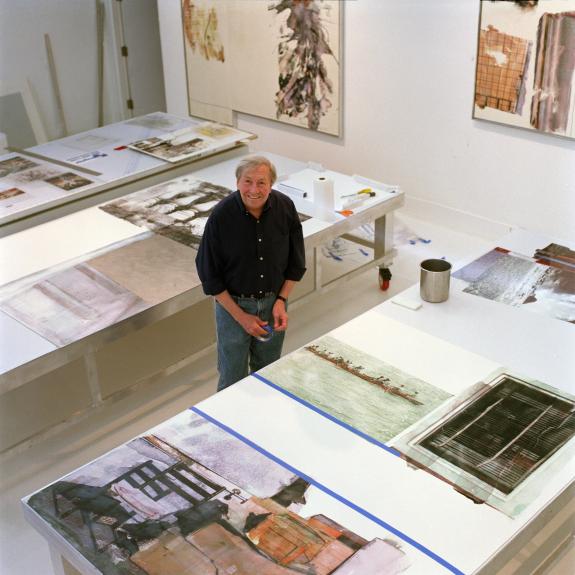
Rauschenberg working on The 1/4 Mile or 2 Furlong Piece (1981–98) in his Laika Lane studio, Captiva, Florida, ca. 1983. Photo: Attributed to Terry Van Brunt
Manche Professoren entschieden sich dazu, ihre Seminare als Livestream im Internet anzubieten. Bisweilen hielten Studenten Referate und verwenden darin Bildmaterial von Künstlern. Dann kamen diese teuflischen Rechtsanwälte und verklagten diese Studenten. 1000,- Euro Strafe, weil die Studis natürlich vorab keine Bildrechte einholten.
Dasselbe droht den Professoren, die mit Bildbeispielen ihre Vorlesungen auflockern wollen, und den webblogs und Zeitschriften und und und.
Daraus werden zwei Konsequenzen gezogen: entweder keine Internet-Streams mehr – oder alle jene Bilder meiden, die mit geldgierigen Bildrechten versehen sind. Dasselbe gilt für die webblogs etc.
Erfreulicherweise hat jetzt eine erste Kunstfoundation die problematische Folge dieser Entwicklung eingesehen: Statt mit Geldforderungen belegte, großartige Kunst anzusprechen, wird kostenloses Mittelmaß benutzt. Konkret: Die Robert Rauschenberg Foundation musste feststellen, dass der Name des Künstlers aus den Medien, aus der Wahrnehmung mehr und mehr verschwunden ist. Daher rudern sie jetzt zurück:“Over time, the Foundation observed that the fear of violating copyright restrictions resulted in two unique challenges. First, due to the prohibitive costs associated with rights and licensing, many scholars and professors limit themselves to using freely available images in their lectures, presentations, and publications, which in turn can alter how art history itself is written and taught. Additionally, image licensing hinders the conversion of print publications to digital formats, due to the costs of obtaining rights for a second time.
Furthermore, given the costs and complexities around using images online and on social media, museums and other institutions are limited in the types of images they can post to their channels. As a result, individual users, not institutions, generate many images of artworks that exist in the digital realm. A lack of “official” images with correct captions and attributions leads to the perpetuation of incorrect information online and on social media.“
hier die komplette Pressemeldung:
Feb. 26, 2016 (New York) – The Robert Rauschenberg Foundation is pleased to announce a new Fair Use policy—the first to be adopted by an artist-endowed foundation—that will make images of Rauschenberg’s artwork more accessible to museums, scholars, artists, and the public.
This new policy comes at an important moment for image rights, as more institutions are providing free and open access to their archives and digitized collections. Prior to 2015, the Rauschenberg Foundation, like many artist foundations and estates, safeguarded the use of images through licensing agents. Over time, the Foundation observed that the fear of violating copyright restrictions resulted in two unique challenges. First, due to the prohibitive costs associated with rights and licensing, many scholars and professors limit themselves to using freely available images in their lectures, presentations, and publications, which in turn can alter how art history itself is written and taught. Additionally, image licensing hinders the conversion of print publications to digital formats, due to the costs of obtaining rights for a second time.
Furthermore, given the costs and complexities around using images online and on social media, museums and other institutions are limited in the types of images they can post to their channels. As a result, individual users, not institutions, generate many images of artworks that exist in the digital realm. A lack of “official” images with correct captions and attributions leads to the perpetuation of incorrect information online and on social media.
In order to address these challenges and the changing landscape of image rights, the Foundation issued pilot licenses to a select group of museums in 2015, including the Art Institute of Chicago, the Museum of Modern Art (MoMA), the Philadelphia Museum of Art, the San Francisco Museum of Modern Art (SFMOMA), and the Tate Modern.
Christy MacLear, CEO of the Rauschenberg Foundation, explained: “In keeping with Rauschenberg’s legacy, the Foundation is always looking to identify challenges and then provide solutions. Traditional notions of copyright and attempts to control images have proven incompatible with the nature of the digital age. Given all of the challenges that have emerged—converting print to digital, promoting scholarly use, and incentivizing museums to use Rauschenberg images—we realized that the greatest impact would come through transferring control to scholars and museums. While in the short-term we’ll certainly see a minor loss of income, we believe the significant increase in scholarship, accessibility, and accuracy more than outweigh the ‘costs’ to the Foundation.”
Inspired by the increased use of Rauschenberg artwork images as a result of this pilot license to museums, the Rauschenberg Foundation has decided to expand its Fair Use policy to the public at large. In the new policy, the Foundation encourages the use and reproduction of Rauschenberg artwork under fair use, eliminating royalty fees, permissions, and license agreements. The public can freely use images of Rauschenberg’s artwork for non-commercial, scholarly, and/or transformative purposes, such as: creative writings; print and digital newspapers and magazines; online teaching tools and study guides; social media; and transformative use in artworks.
The Foundation’s new policy is built upon best practices published last year by the College Art Association.
Further details about the Fair Use policy can be found on the Foundation’s website:
http://www.rauschenbergfoundation.org/foundation/fair-use
About the Robert Rauschenberg Foundation
The Robert Rauschenberg Foundation fosters the legacy of the life, artistic practice, and activist philosophy of one of the most important artists of the 20th century. Through exhibitions, scholarship, grants, and a residency program, the Foundation furthers Rauschenberg’s belief that art can change the world, while ensuring that his singular achievements and contributions continue to have global impact and resonance with contemporary artists.

